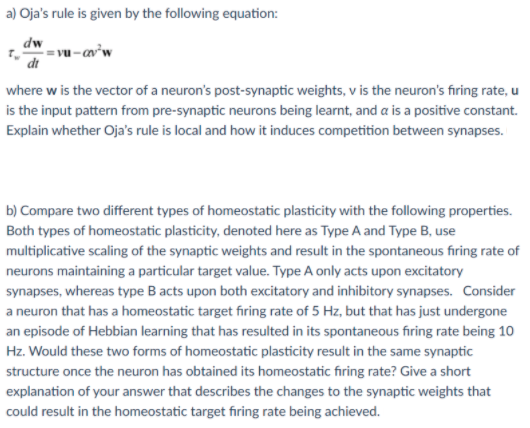Human Physiology: From Cells to Systems (MindTap Course List)
9th Edition
ISBN:9781285866932
Author:Lauralee Sherwood
Publisher:Lauralee Sherwood
Chapter4: Principles Of Neural And Hormonal Communication
Section: Chapter Questions
Problem 4TAHL: Assume presynaptic excitatory neuron A terminates on a postsynaptic cell near the axon hillock and...
Related questions
Question

Transcribed Image Text:a) Oja's rule is given by the following equation:
dw
av’w
where w is the vector of a neuron's post-synaptic weights, v is the neuron's firing rate, u
is the input pattern from pre-synaptic neurons being learnt, and a is a positive constant.
Explain whether Oja's rule is local and how it induces competition between synapses.
b) Compare two different types of homeostatic plasticity with the following properties.
Both types of homeostatic plasticity, denoted here as Type A and Type B, use
multiplicative scaling of the synaptic weights and result in the spontaneous firing rate of
neurons maintaining a particular target value. Type A only acts upon excitatory
synapses, whereas type B acts upon both excitatory and inhibitory synapses. Consider
a neuron that has a homeostatic target firing rate of 5 Hz, but that has just undergone
an episode of Hebbian learning that has resulted in its spontaneous firing rate being 10
Hz. Would these two forms of homeostatic plasticity result in the same synaptic
structure once the neuron has obtained its homeostatic firing rate? Give a short
explanation of your answer that describes the changes to the synaptic weights that
could result in the homeostatic target fıring rate being achieved.
Expert Solution
This question has been solved!
Explore an expertly crafted, step-by-step solution for a thorough understanding of key concepts.
Step by step
Solved in 2 steps with 6 images

Knowledge Booster
Learn more about
Need a deep-dive on the concept behind this application? Look no further. Learn more about this topic, biology and related others by exploring similar questions and additional content below.Recommended textbooks for you

Human Physiology: From Cells to Systems (MindTap …
Biology
ISBN:
9781285866932
Author:
Lauralee Sherwood
Publisher:
Cengage Learning

Human Physiology: From Cells to Systems (MindTap …
Biology
ISBN:
9781285866932
Author:
Lauralee Sherwood
Publisher:
Cengage Learning